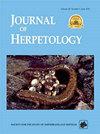A New Cryptic Species of Boana (Hylinae: Cophomantini) of the B. polytaenia Clade from the Brazilian Atlantic Forest
IF 0.8
4区 生物学
Q3 ZOOLOGY
引用次数: 0
Abstract
Abstract. A recent systematic revision pointed out that the name Boana polytaenia has been applied to a nonmonophyletic assemblage because populations identified as B. polytaenia from the northern Mantiqueira and southern Espinhaço mountain ranges are not closely related with the species' nominal clade. In this sense, specimens from these two biogeographic regions were recovered within two clades named Boana sp. 3 and Boana sp. 4, respectively. Here we characterized and compared external morphologies, calls, and DNA of specimens of the clade of B. polytaenia and from the two candidate species (Boana sp. 3 and Boana sp. 4). From these comparisons we herein describe a new cryptic species. Boana guarinimirim sp. nov. differs from its closely related species by the presence of a supracloacal crest, calcar appendage, and conspicuous discs on toes. Nevertheless, the new species could not be completely discriminated from its distantly related taxon B. polytaenia. We applied the new name to the clade distributed throughout the northern Mantiqueira range (Boana sp. 3), but the new name could also be applied to the clade from southern Espinhaço range (Boana sp. 4). Additional sampling efforts and new sources of evidence, such as larvae morphology and chromosomal features, should evaluate whether the lineages are conspecifics.标题巴西大西洋森林多带木枝一新种(水螅亚科:水螅)
摘要最近的一项系统修订指出,polytaenia这一名称已被应用于一个非单系组合,因为在Mantiqueira北部和espinhaarso山脉南部被鉴定为polytaenia的种群与该物种的名义分支关系并不密切。从这个意义上说,这两个生物地理区域的标本分别在Boana sp. 3和Boana sp. 4两个分支中恢复。在这里,我们对多taenia B.分支和两个候选物种(Boana sp. 3和Boana sp. 4)的外部形态、叫声和DNA进行了表征和比较。通过这些比较,我们在此描述了一个新的隐种。11 . Boana guarinimimrim sp. 11 .不同于它的密切相关的物种的存在,在趾头上有一个骨嵴,后跟附属物,和明显的盘。然而,该新种不能完全与其远亲分类群B. polytaenia区分开来。我们将新名称应用于分布在Mantiqueira山脉北部的分支(Boana sp. 3),但新名称也可以应用于espinhao山脉南部的分支(Boana sp. 4)。额外的采样工作和新的证据来源,如幼虫形态和染色体特征,应该评估谱系是否具有同种性。
本文章由计算机程序翻译,如有差异,请以英文原文为准。
求助全文
约1分钟内获得全文
求助全文
来源期刊

Journal of Herpetology
生物-动物学
CiteScore
1.60
自引率
0.00%
发文量
45
审稿时长
6 months
期刊介绍:
The Journal of Herpetology accepts manuscripts on all aspects on the biology of amphibians and reptiles including their behavior, conservation, ecology, morphology, physiology, and systematics, as well as herpetological education. We encourage authors to submit manuscripts that are data-driven and rigorous tests of hypotheses, or provide thorough descriptions of novel taxa (living or fossil). Topics may address theoretical issues in a thoughtful, quantitative way. Reviews and policy papers that provide new insight on the herpetological sciences are also welcome, but they must be more than simple literature reviews. These papers must have a central focus that propose a new argument for understanding a concept or a new approach for answering a question or solving a problem. Focus sections that combine papers on related topics are normally determined by the Editors. Publication in the Long-Term Perspectives section is by invitation only. Papers on captive breeding, new techniques or sampling methods, anecdotal or isolated natural history observations, geographic range extensions, and essays should be submitted to our sister journal, Herpetological Review.
 求助内容:
求助内容: 应助结果提醒方式:
应助结果提醒方式:


